By Suhani Singh
Our first blog in this series looked at the overall polling trends during the last Ontario election and our last blog examined how party support differs among women and men during the Ontario election campaign. This blog will examine different age groups to see how they changed during the Ontario precampaign and campaign period for the 2018 election.
The age groups looked at are divided into five generations (Gen ZY, Gen YX, Gen X, Young Boomer, and Boomers). The table below shows who is included in these age groups. These age groups sometimes differed among polling firms which created some challenges for collecting data. The few adjustments that were made to the age groups for data collecting purposes are described below.
| Age Group (yrs) | Generation Name | Modifications made |
| 18-34 | Gen ZY | The data includes 18-29, 29-34 and <35 years groups |
| 35-44 | Gen YX | The data includes 35-44, 35-49 and 30-44 groups |
| 45-54 | Gen X | The data includes 45-54 and 45-59 groups |
| 55-64 | Young Boomers | The data includes 50-64 and 55-64 groups |
| 65+ | Boomers & Greatest Generation | The data includes 60+ and 65+ groups |
Some polling firms divided the age groups as 18-34, 35-54, and 55+ years as oppose to the above-mentioned age groups. The age groups reported as 35-54, and 55+ were removed from our analysis and graphs because they will not give us true representation of our selected demographic due to the large age range that spans multiple generations. After removing unusable age data, each age group was plotted on a scatter graph to better compare how each generation changed over time, how they may differ from each other, and how they compare to the provincial average.
Conservative support among Gen ZY stayed rather consistent from the pre-campaign period up until the election at about 30% with few outliers. The NDP polled much lower during the pre-campaign period at 20% – 35%. The levels were similar to the Liberal Party, but unlike their counterparts, the NDP was able to rise significantly among young voters, polling between 30% – 50% throughout the campaign period. The Liberal Party saw their support drop over the four-month period, polling between 10% – 20% by the end of the campaign.
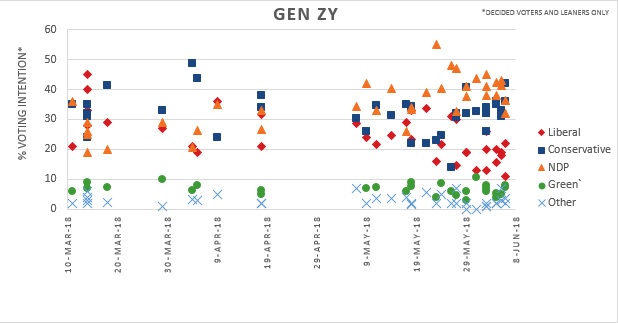
Gen YX party preference shows steady and consistent support for the Conservatives throughout the pre-campaign and campaign periods at close to 40%, only slightly dropping under 40% closer to the election. The NDP and Liberals started with similar support between 20% – 30%. Like other age groups and the provincial average, the NDP rose significantly by the end of the campaign period to 30% – 40% to create a close race with the Conservatives.
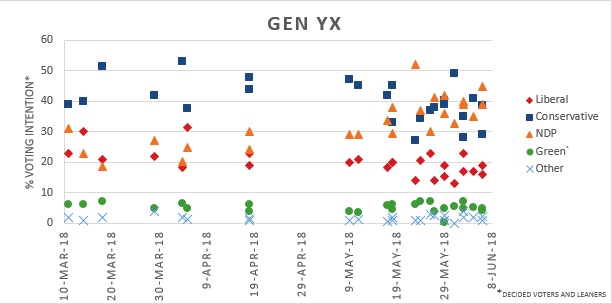
Gen X largely supported the Conservatives and maintained a steady voting preference at 40%. NDP support did increase over time from 25% to above 35%. Liberal support fell from 25% to some polls reaching under 20%. It is worth noting that Gen X contains a significantly smaller amount of polling data due to the limited number of polling firms that had a 45-54 or 45-59 category and the removal of the 34-54 age group. Although trends can be seen here, they should be taken with more caution.
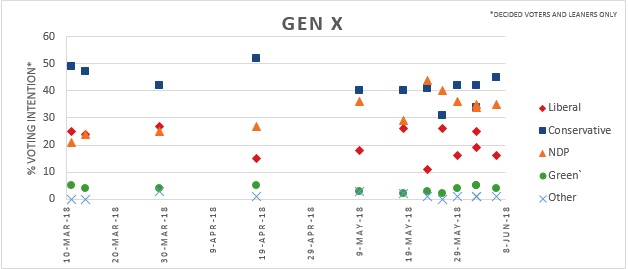
The Conservatives had steady support from Young Boomers, polling slightly above the national average at 40%, which fell slightly to 35% in some polls during the campaign period. Support for the NDP grew over time leading the party to poll around 25% – 40% near the election. The Conservatives and NDP were close as the election approached but the Conservatives came out with higher support. Like with other groups, the Liberal Party remained below the PCs and NDP, polling between 15% – 25%.
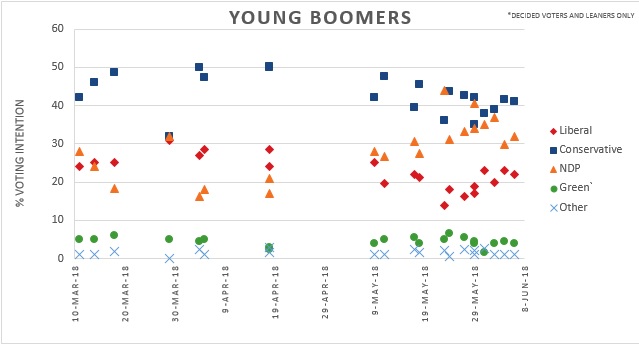
The voting intentions among Boomers leaned towards the Conservatives at almost 50% in the precampaign period. As was seen provincially and among all other age groups, Conservative support dropped as the campaign period started and the election approached, falling to 35% – 45%. Conservative support among Boomers is still distinguishable from other age groups as the party was clearly ahead in the polls right before the election. Support for NDP increased during the campaigning to 30% – 40% from under 20% in precampaign period. However, this large increase was still not high enough to overtake the Conservatives.
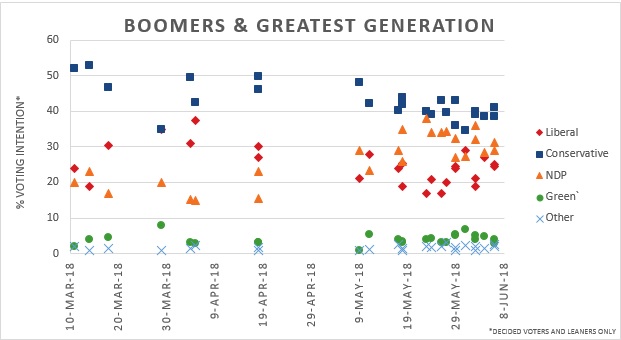
Similar trends of high Conservative, competing NDP, and low Liberal support can be observed across all the age groups in this blog which is comparable to what was observed in the gender and province-wide demographics. The next blog will be the fourth and final blog in this series which will look at voter intentions in the different regions of Ontario.
